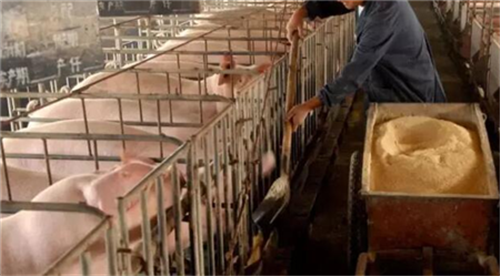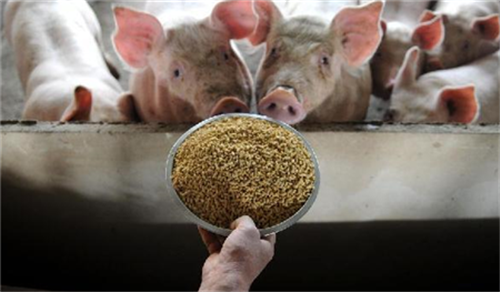Pregnant sows with better fat condition are more likely to die suddenly. What is the cause?
Sudden death of sows occurs in all regions, especially pregnant sows with good body condition, accounting for 80% of the mortality. The causes of death are multiple and diverse, some belong to gastrointestinal flatulence, some belong to stress, and some pathogens are infected. Endotoxin poisoning leads to body grams; some nutritional requirements are excessive, and the physiological burden is heavy will also lead to acute death.
The death of pregnant sows is undoubtedly a hidden danger to pig farms. The most important thing for this disease is prevention. The nutrition intake and health status of sows during pregnancy are all affected. If you want to control the epidemic of this disease in pig farms, it is necessary to understand what causes sudden death of pregnant sows.
1. Intestinal bleeding, collapse and death
After pregnancy, sows are fed a large amount of feed containing crude fiber, lack of drinking water, little supplement to green feed, long-term living in a space with a small range of activities, or even no room for movement. Over time, sows gain a lot of weight, good body condition and severe constipation, coupled with lack of gastrointestinal peristalsis and many other factors, resulting in overload of heart and lung in sows. Compression leads to rupture of the inferior mesenteric artery, which leads to hemorrhage and massive bleeding, and finally collapses to death in a short time.
Sudden death mainly occurred in late pregnancy and prenatal period, sows suddenly fell to the ground and died, accompanied by gastrointestinal bleeding, pale skin, shortness of breath before death, muscle trembling, unable to stand, dry knot of faeces excreted by sows, accompanied by undigested feed, poor mental condition, died 3-5 minutes after falling to the ground, there was no time for treatment and rescue.
2. Gastrointestinal flatulence and death
Pregnant sows which occur frequently in the first trimester, which usually occur in 1-2 months, are mainly caused by Clostridium welchii. When there is a mutation in the external environment, the resistance of pregnant sows is at a low level and the intestinal flora is maladjusted, resulting in the rapid reproduction of Clostridium welchii pathogens and the production of toxins, resulting in necrotizing enteritis caused by intestinal diffuse bleeding.
Generally showed sporadic outbreaks, and acute onset, short course of disease, high mortality, mortality rate of 100%, after the onset of disease pig abdominal distension, percussion with fingers when issued a drum sound, mostly in the cold and wet winter and spring.
Manifestations of sudden death: asymptomatic sudden fall to the ground, convulsive death, dyspnea, open mouth breathing, typical abdominal breathing, and generally fat sows in pig farms. During the fall, there were muscle tremors, ataxia, limb strokes and skin whitening; there was no time for treatment and rescue.
In general, the body temperature of diseased pigs is normal, and abdominal distension occurs after death; individual body temperature rises and decreases after death; there are also some diseased pigs with white foam flowing from the mouth and nose.

3. Pathogen and parasite infection
The death of pregnant sows is also related to some diseases. Sows themselves carry immunosuppressive pathogens such as blue ear and circovirus, coupled with immunosuppressive factors such as mycin in feed. when it is eroded by some stress factors or other pathogens in the later stage of pregnancy, the balance between autoimmunity and pathogenic factors is destroyed, which leads to disease and even death of sows.
This includes medical, obstetrical or nutritional causes, as well as infectious and viral diseases; Toxoplasma gondii infection is the main cause of death in pregnant sows.
Sudden death: disease death caused by pathogen infection, symptoms such as elevated body temperature, loss of appetite, mental distress, heart failure, indigestion, inability to stand, rapid heartbeat, dyspnea, wheezing and gradual weight loss in diseased pigs.
Symptoms of the disease include classical swine fever, cycline, blue ears, pseudorabies and so on; some do not eat before death, lying on the side of death, bloody fluid outflow from the mouth, no other obvious lesions on the body surface.
4. Excessive nutrition intake
During pregnancy, feeding too much feed will increase the metabolic burden of sows, lead to death due to obesity, excessive crude fiber content in feed and excessive intake, which will lead to overweight feeling and excessive deposition of fat around the uterus, subcutaneous and abdominal cavity, which will cause disturbance of blood circulation in uterine wall, disorder of metabolism and body balance mechanism of mother and fetus, and decrease of resistance.
In addition, the feed of sows was not changed in time during pregnancy, resulting in overnutrition of sows. The manifestation of sudden death: in the middle and later stage of pregnancy, the body temperature was lower than 38 ℃, the sick pigs developed constipation, emotional agitation, restlessness, loss of appetite or abstinence, lying on the ground, uncoordinated walking, mental depression, some pigs showed neurological symptoms, muscle tremor, and shook their heads. Finally, the coma gradually weakened and died.
Comprehensive prevention to avoid the death of pregnant sows
In feeding management, attention should be paid to quantity and collocation, concentrate and roughage can be fed appropriately, and certain green feed can be supplemented, so that the gastrointestinal tract of pigs can be assisted to increase peristalsis, and feed should be kept dry and fresh. less frequent feeding should be used when feeding, and sows can drink clean water at any time.
After the occurrence of gastrointestinal gas, there is no relative drug for treatment, which can be prevented by adding tamoxin to the feed. Methanidazole and lincomycin also have a strong inhibitory effect on Clostridium welchii.
In addition, some viral diseases should be vaccinated all the year round, and bacterial diseases should also be prevented. Vitamins can be used for health care at ordinary times, provide more green feed, deworming 4 times a year, strengthen feed management of pigs, reduce stress, and improve the resistance of pregnant sows.
Carry on the reasonable feeding plan to the pregnant sow, feed more green feed, monitor the fat condition of the sow every day, carry on the feeding adjustment, control the energy material in the feed for the fat sow, adopt the progressive way of reducing every day, so that the sow can play its own regulating function, which can reduce and avoid the death caused by continued obesity.
There is also a bad environment can also cause bacterial infection, so pregnant sows should be kept dry and hygienic, sows should not be hurt when consuming with pigs, appropriate disinfectants should be selected, and sows should be given an appropriate amount of exercise space during pregnancy. Free activities can be carried out to ensure that the body is in a healthy state; according to the seasons, the pig house should take proper measures to prevent heat and cool down in summer. Keeping the pig house warm in winter can reduce the number of activities.
- Prev

Most people have got it wrong about the reason why sows don't have estrus and the normal order of reminding.
Most people have got it wrong about the reason why sows don't have estrus and the normal order of reminding.
- Next

How many reasons are there for pigs not eating well in hot weather? How to solve?
How many reasons are there for pigs not eating well in hot weather? How to solve?
Related
- On the eggshell is a badge full of pride. British Poultry Egg Market and Consumer observation
- British study: 72% of Britons are willing to buy native eggs raised by insects
- Guidelines for friendly egg production revised the increase of space in chicken sheds can not be forced to change feathers and lay eggs.
- Risk of delay in customs clearance Australia suspends lobster exports to China
- Pig semen-the Vector of virus Transmission (4)
- Pig semen-the Vector of virus Transmission (3)
- Five common causes of difficult control of classical swine fever in clinic and their countermeasures
- Foot-and-mouth disease is the most effective way to prevent it!
- PED is the number one killer of piglets and has to be guarded against in autumn and winter.
- What is "yellow fat pig"? Have you ever heard the pig collector talk about "yellow fat pig"?

